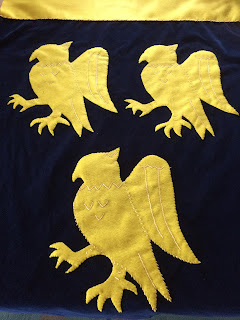 I don't know the artist of this particular pattern but it is a good indicator of how the layout of my tunic looked. I didn't use a faced neckline because the wool was quite bulky, but the rest of the layout is very similar. I measured the wearer's body and added a little extra for ease of movement plus seam allowances.
I don't know the artist of this particular pattern but it is a good indicator of how the layout of my tunic looked. I didn't use a faced neckline because the wool was quite bulky, but the rest of the layout is very similar. I measured the wearer's body and added a little extra for ease of movement plus seam allowances.Once the seams were sewn, I whipped the seams open and down.
I added a supportive placket around the collar split so that the pressure of normal wearing wouldn't end up ripping the split at the front.
The rest of the neckline was turned down with a small hand-sewn hem to reduce bulk.
I left this tunic plain so that the recipient could sew trim on if he wanted. I have yet to get a photo of him wearing it, but it looks nice on.



















